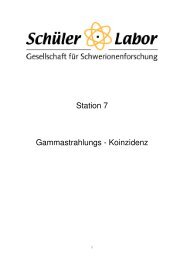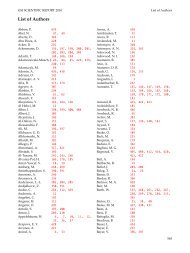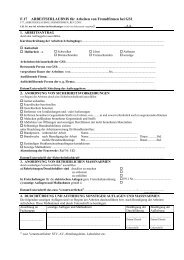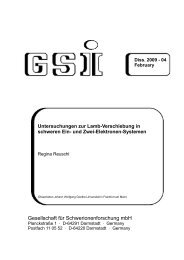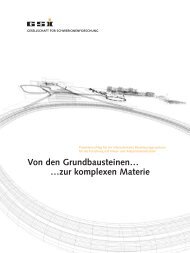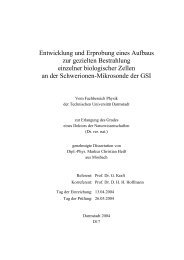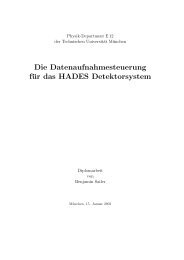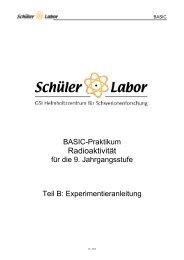CBM Progress Report 2006 - GSI
CBM Progress Report 2006 - GSI
CBM Progress Report 2006 - GSI
Create successful ePaper yourself
Turn your PDF publications into a flip-book with our unique Google optimized e-Paper software.
<strong>CBM</strong> <strong>Progress</strong> <strong>Report</strong> <strong>2006</strong> Detector Developments<br />
Silicon Microstrip Sensor Prototypes for <strong>CBM</strong><br />
M. Merkin, D.Karmanov, N.Baranova<br />
Skobeltsyn Institute of Nuclear Physics, Lomonosov Moscow State University<br />
N.Egorov, S.Golubkov, A.Sidorov<br />
Research Institute of Material Science and Technology, Zelenograd, Moscow<br />
We have started to explore the design and the production<br />
of double-sided microstrip sensors for <strong>CBM</strong>'s Silicon<br />
Tracking System, with focus on thin detectors and<br />
radiation tolerant design features.<br />
Double-sided strip sensors: Thin, radiation hard<br />
Silicon sensors are essentially not commercial products.<br />
Custom geometries and a variety of special requirements<br />
have to be taken into account for a given application.<br />
For the <strong>CBM</strong> experiment, the challenge is to establish<br />
reliable technologies for the processing of both sides of<br />
thin silicon wafers. The goal is to manufacture low-mass<br />
double-sided sensors with long, fine-pitch charge<br />
collecting strips, laid out in a radiation tolerant design.<br />
There is very limited experience in the world on the<br />
production of double-sided radiation tolerant sensors.<br />
R&D steps<br />
For this project, High Reflectivity Wafers (HiREF®)<br />
from Wacker-Siltronic have been used. The planned R&D<br />
steps are:<br />
(1) Sensor design and mask production:<br />
a. Single-sided test detectors with 50 µm strip pitch<br />
and DC or AC readout.<br />
b. Double-sided sensors with 50 µm strip pitch and<br />
15º stereo angle between front-and back sides.<br />
Strips poly-silicon biased, AC-coupled readout.<br />
(2) Production of 250 µm sensors.<br />
(3) Optimization of the sensor design.<br />
(4) Technology optimization of the production process.<br />
(5) Production of 200 µm sensors.<br />
(6) Detailed tests of the produced sensors.<br />
First results from single-sided sensors<br />
Two batches of test wafers have been processed in steps<br />
(1a) and (2) to qualify the 250 µm wafer material for the<br />
forthcoming production: One batch of sensors with 2 cm<br />
long single-sided DC strips of 50 µm pitch on 2 × 4 cm 2<br />
area, and one batch with single-sided AC-coupled strips<br />
of the same design. Measurements with the DC strip<br />
Leakage current, nA<br />
4000<br />
3500<br />
3000<br />
2500<br />
2000<br />
1500<br />
1000<br />
500<br />
0<br />
Sensor #4041<br />
0 50 100 150 200 250 300 350<br />
Bias voltage, V<br />
Figure 1: Current-voltage characteristics of a single-sided<br />
microstrip sensor on a HiREF® silicon wafer.<br />
sensors are shown in Fig.1. The IV-characteristics<br />
indicates good wafer material, with full depletion at around<br />
100 V and high-voltage breakdown beyond 500 V. The<br />
leakage current for the given resistivity of 3 kOhm and the<br />
given thickness of 250 µm is reasonable: about 5 nA/strip.<br />
We can therefore proceed with the R&D steps as planned.<br />
Design and production of double-sided sensor<br />
The study of double-sided strip sensors matching the <strong>CBM</strong><br />
specifications is in the center of our project. The design of<br />
a prototype sensor was recently completed (step 1b).<br />
Figures 2 and 3 show the corner regions of the N-side, and<br />
P-side. The stereo angle of the P-strips with respect to the<br />
N-strips is clearly seen, as well as the small DC probe pads<br />
and the double-row of larger AC readout pads. The design<br />
takes into account several features to enhance the radiation<br />
tolerance of the detector: Poly-silicon bias resistors on both<br />
the P and the N sides, P-stop implants between the strips<br />
on the N-side, and a multi-guard ring structure. The<br />
production masks have been fabricated. The complete set<br />
consists of 17 masks: 7 for the P-side, 9 for the N-side, and<br />
one additional mask for fiducial marks.<br />
After full characterization of the test sensors, the<br />
production of double-sided microstrip sensor prototypes<br />
will be started with 250 µm wafers or thinner.<br />
31<br />
Figure 2: N-side design.<br />
Figure 3: P-side design.



